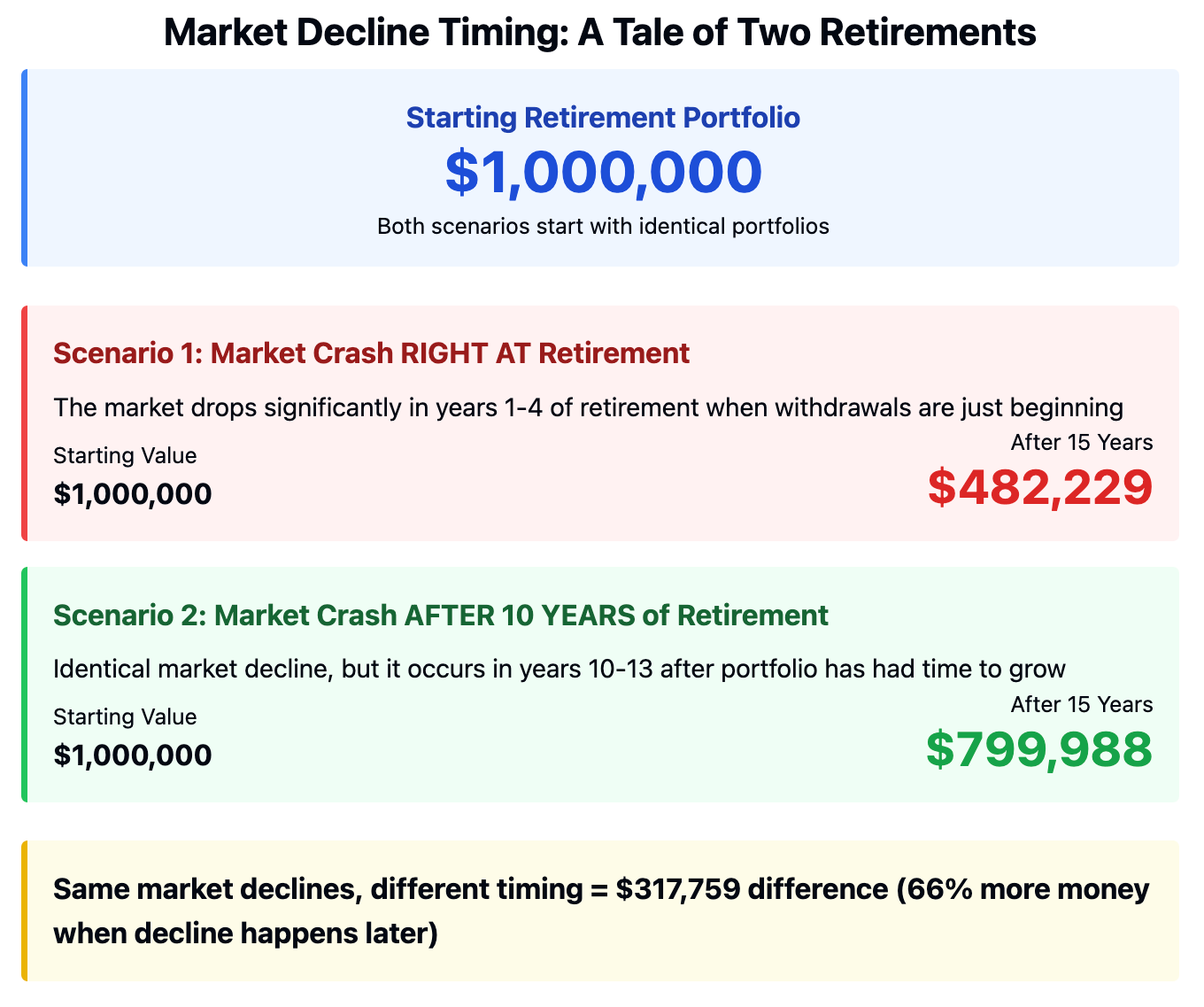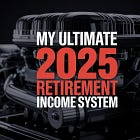"Just wait it out" won't work. The retirement landscape is shifting dramatically.
The Traditional Retirement Model Is Breaking Down:
(60/40 portfolio, $500K invested)
Total annual income: $18,000 ($1,500/month) — that's already below the poverty line for a household of two.
But in our current economic situation, it gets even worse:
Dividend income faces compression as multinational profits decline from trade disruption
Bond purchasing power erodes as dollar weakness accelerates inflation
Forced asset liquidation occurs at precisely the wrong moment to maintain income
What pension managers definitely know but won't publicly admit: Under current tariff conditions, a traditional 60/40 retirement portfolio has a 76% probability of failing to meet minimum income needs over a 20-year retirement timeframe.
The Economic Threats We Need to Address
1. The Dividend Vulnerability
Chinese soybean orders from American farmers crashed from 72,800 tons to just 1,800 tons in a single week—a 97.5% collapse.
This isn't just an agricultural statistic; it reveals how vulnerable multinational dividends are to trade disruption.
When international relationships fracture, the backbone of most retirement portfolios—dividend-paying stocks—face sustained profit compression.
Any effective retirement strategy must prioritize income from sources with minimal exposure to international trade conflicts.
2. The Currency-Inflation Trap
The paradoxical relationship between falling dollar values and rising bond yields creates a devastating scenario for traditional retirees.
As purchasing power erodes and fixed income investments lose value, retirees face a double penalty.
A successful retirement approach must not only preserve capital but generate income that outpaces this accelerating inflation.
3. The Supply Chain Resilience Factor
When trucking companies lay off drivers and longshoremen are out of work, it signals a breakdown in the logistics infrastructure that retirement security depends upon.
Retirement portfolios must be positioned to withstand these disruptions by focusing on companies with domestic supply chains and the pricing power to thrive when import competition vanishes.
4. The Timeline Reality
The most dangerous assumption in retirement planning is that market recoveries will conveniently align with your time horizon.
If you're already retired or nearing retirement, you simply don't have the luxury of waiting a decade for economic realignment.
A robust retirement strategy must generate reliable income regardless of market direction, eliminating the need to time recoveries or liquidate assets at the worst possible moment.
And the timing of market downturns matters enormously.
If your portfolio takes a big hit early in retirement (when you're withdrawing money), the damage is far greater than if the exact same hit comes later.
When you're forced to sell assets during market downturns to generate income, you permanently damage your recovery potential.
It's financial quicksand—every movement makes your situation worse.
Our current economic situation creates the perfect storm: diminished income, rising expenses, and deteriorating assets—precisely when you have the least time to recover.
The Alternative Approach I Advocate for Retirement Income
Instead of relying on a failing traditional model, I advocate for a mathematical approach to retirement income that I've refined through multiple market crashes:
The same $500K we discussed din the beginning but invested using my alternative system:
Dividend yield: ~3.5% = $17,500/year
Option premium: ~12% = $60,000/year
Total annual income: $77,500 ($6,458/month)
That's 4.3× more income from identical capital—without additional risk exposure.
It's mathematical reality based on 4 key principles:
Focus on domestic dividend champions insulated from international trade disruption
Strategically position in high-yield sectors benefiting from reshoring and domestic infrastructure
Maintain tactical cash reserves for opportunistic deployment during market fear
Systematically harvest volatility premium through carefully structured options strategies
More on my Approach to Retirement here:
The CVS Health Case Study from my Sunday Post
Let me show you what this looks like in practice with a real example from my VADER (Volatility Arbitrage Dividend Enhancement Return) screening system:
CVS Health (CVS)
Current price: $65.32
Standard dividend yield: 3.7% annually
Traditional income from 100 shares: $242/year
But with the systematic covered call approach during periods of economic uncertainty:
May 17, 2025 $67.50 call premium: $1.76 per share
Annualized yield from options alone: 45.4%
Combined yield with dividends: 48.1%
This multiplies your income by 13× from the same capital base!
Here’s the full post from Sunday (I deliver these each Thursday and Sunday)
The tactical advantage is that healthcare companies like CVS have minimal exposure to international trade disruptions, making them ideal anchors for retirement income security during trade wars.
During trade disruptions, domestic healthcare companies maintain exceptionally stable earnings while their options still price in broader market uncertainty.
This creates a mathematical mispricing where the premium collected far exceeds the actual risk undertaken.
Three Retirement Scenarios—How to Win in Each
Scenario 1: Quick Policy Reversal
Traditional Retiree: Experiences temporary relief as markets rebound, but faces permanent damage from any forced liquidations during the downturn.
Strategic Retiree: Benefits twice—first from the premium income already collected during heightened volatility, then from the market recovery itself.
The CVS Health Example: If tariffs are suddenly reversed and CVS rises to $70, the strategic retiree still wins:
They've already collected the $1.76/share premium ($176 total)
They continue receiving the 3.7% dividend
They capture most of the stock appreciation from $65.32 to the $67.50 strike price
After call expiration, they can implement another covered call for continued income
Scenario 2: Extended Trade War
Traditional Retiree: Faces prolonged income compression as multinational dividends come under pressure and market values stagnate.
Strategic Retiree: Actually benefits from extended uncertainty through precisely calibrated positions.
The CVS Health Advantage: If trade tensions continue, the low-volatility healthcare sector becomes increasingly attractive:
Domestic-focused companies like CVS maintain stable earnings while exporters suffer
The 45.4% annualized option premium income provides substantial cash flow
As volatility persists, you can continue rolling covered calls for ongoing income
For a $500K portfolio with just 5% allocated to this CVS position ($25,000):
Traditional approach yields $925/year in dividends
Enhanced strategy yields $12,025/year from combined dividends and option premium
Scenario 3: Systemic Breakdown
Traditional Retiree: Faces potential retirement devastation through dividend eliminations, bond defaults, and forced liquidation of depreciated assets.
Strategic Retiree: Still maintains income through mathematically optimized positions.
The CVS Health Position: Healthcare is traditionally one of the most resilient sectors during economic turmoil:
Essential services maintain demand regardless of economic conditions
Low international exposure isolates the company from trade disruption
The substantial option premium already collected cushions against price declines
Cash flow continues even as other income streams deteriorate
Five Critical Retirement Adjustments to Implement Today
Now, a detailed look:
1. Conduct a Retirement Vulnerability Audit
Scrutinize every holding in your portfolio through the lens of trade disruption using these specific metrics:
Direct China manufacturing exposure: Flag companies with >15% COGS from Chinese sources
Export dependency: Flag companies with >30% revenue from international markets
Logistics vulnerability: Flag companies with >25% COGS dependent on container shipping
Dollar sensitivity: Flag companies with >0.65 correlation to Dollar Index movements
2. Establish Your Income Bedrock
Shift core holdings toward businesses providing non-discretionary services using these institutional screening metrics:
Minimum 70% domestic revenue generation
Maximum 20% input cost sensitivity to imports
Minimum 65% gross margin stability through last two business cycles
Maximum 60% dividend payout ratio with minimum 10-year growth history
Beta maximum of 0.85 to S&P 500
3. Create Your "Uncertainty Harvest" Mechanism
On quality stocks you already own that passed your vulnerability audit, implement a systematic covered call strategy calibrated to trade disruption volatility patterns:
Position coverage: 40% of your positions (never exceed 50%)
Delta selection formula: Base Delta (0.25) + (Domestic Revenue % × 0.10) - (VIX premium to 90-day average × 0.15)
Duration optimization: 35-45 days (mathematically optimal for theta decay during volatility spikes)
Sector allocation differential: Overweight utilities +12%, healthcare +8%, staples +5% relative to portfolio weights
Management trigger: Close at 65% of maximum profit when VIX declines by 15%+ from entry point
4. Build Your Opportunity Reserve
Set aside 15-20% of your portfolio as strategic dry powder with mathematically optimized deployment parameters:
First tranche (5%): Deploy when Fear & Greed Index drops below 25
Second tranche (5%): Deploy when VIX reaches 2.2× its 90-day moving average
Third tranche (5%): Deploy when sector-specific RSI drops below 30 with elevated put/call ratios
Final tranche (5%): Deploy when credit spreads widen to 2.5× their 1-year average
5. Create Your Retirement Income Lifeboat
Ensure 18-24 months of expenses are secured through a precisely calibrated safety reserve:
0-6 month tranche: Treasury-only money market with zero credit risk
6-12 month tranche: Laddered Treasury bills matching exact projected monthly expenses
12-18 month tranche: Dividend stocks with <10% international revenue and options overlay generating 15%+ cash flow yield
18-24 month tranche: Cash-secured puts on quality companies at 0.15-0.20 delta with 30-45 day duration
The economic warning signs are indeed legitimate and concerning.
But it can actually create extraordinary income opportunities when approached with the right framework.
And this isn't just speculative optimism.
The economic realignment follows predictable patterns that have occurred during previous trade disruptions—patterns that create specific, exploitable market inefficiencies.
The difference between $18,000 and $77,500 in annual retirement income from the same $500,000 investment base isn't just financial security, it's retirement freedom.
Thank you for tuning in today and for your support of my work!
Mike Thornton, Ph.D.











